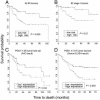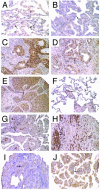Protein profiles associated with survival in lung adenocarcinoma
- PMID: 14573703
- PMCID: PMC263849
- DOI: 10.1073/pnas.2233850100
Protein profiles associated with survival in lung adenocarcinoma
Abstract
Morphologic assessment of lung tumors is informative but insufficient to adequately predict patient outcome. We previously identified transcriptional profiles that predict patient survival, and here we identify proteins associated with patient survival in lung adenocarcinoma. A total of 682 individual protein spots were quantified in 90 lung adenocarcinomas by using quantitative two-dimensional polyacrylamide gel electrophoresis analysis. A leave-one-out cross-validation procedure using the top 20 survival-associated proteins identified by Cox modeling indicated that protein profiles as a whole can predict survival in stage I tumor patients (P = 0.01). Thirty-three of 46 survival-associated proteins were identified by using mass spectrometry. Expression of 12 candidate proteins was confirmed as tumor-derived with immunohistochemical analysis and tissue microarrays. Oligonucleotide microarray results from both the same tumors and from an independent study showed mRNAs associated with survival for 11 of 27 encoded genes. Combined analysis of protein and mRNA data revealed 11 components of the glycolysis pathway as associated with poor survival. Among these candidates, phosphoglycerate kinase 1 was associated with survival in the protein study, in both mRNA studies and in an independent validation set of 117 adenocarcinomas and squamous lung tumors using tissue microarrays. Elevated levels of phosphoglycerate kinase 1 in the serum were also significantly correlated with poor outcome in a validation set of 107 patients with lung adenocarcinomas using ELISA analysis. These studies identify new prognostic biomarkers and indicate that protein expression profiles can predict the outcome of patients with early-stage lung cancer.
Figures




References
-
- Hoffman, P. C., Mauer, A. M. & Vokes, E. E. (2000) Lancet 355, 479-485. - PubMed
-
- Fry, W. A., Philips, J. L. & Menck, H. R. (1999) Cancer 86, 1867-1876. - PubMed
-
- Martins, S. J. & Pereira, J. R. (1999) Am. J. Clin. Oncol. 22, 453-457. - PubMed
-
- Brundage, M. D., Davies, D. & Mackillop, W. J. (2002) Chest 122, 1037-1057. - PubMed
-
- Rosell, R., Pifarre, A., Monzo, M., Astudillo, J., Lopez-Cabrerizo, M. P., Calvo, R., Moreno, I., Sanchez-Cespedes, M., Font, A. & Navas-Palacios, J. J. (1997) Int. J. Cancer (Pred. Oncol.) 74, 330-334. - PubMed
Publication types
MeSH terms
Substances
Grants and funding
LinkOut - more resources
Full Text Sources
Other Literature Sources
Medical

